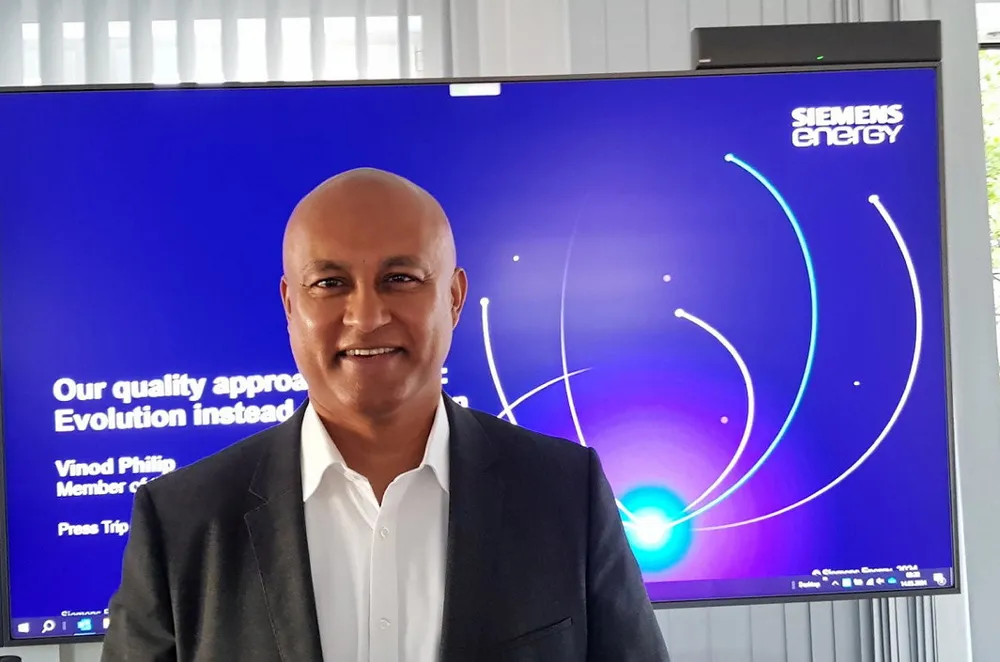New Siemens Gamesa CEO Vinod Philip confident of 2026 break-even
Vinod Philip says main causes of problems at 4.X and 5.X onshore platforms are now understood and solutions will be implemented step by step

Vinod Philip, who will take over as new CEO at Siemens Gamesa on 1 August, said he is confident that the wind turbine manufacturer will reach break-even by 2026 as problems at the company’s troubled 4.X and 5.X onshore wind platforms are now understood.
Outgoing CEO “Jochen Eickholt and his team have developed a plan and I'm very confident that we’ll reach break-even in wind in 2026. So far, we have not seen anything that would jeopardise our goal of breaking even by 2026,” Philip told journalists in Mülheim an der Ruhr, Germany, last week.
Philip added that he is meeting Eickholt regularly to tap into his assessment of the situation and prepare a smooth transition at the top.
Siemens Gamesa since mid-last year has been racing to evaluate the nature and scale of the problem with its latest onshore wind platforms, and Bruch little later set up a task force consisting of experts from both Siemens Gamesa and Siemens Energy to get to the root causes of the technological issues at the 4.X and 5.X platforms.
In the meantime, the company has paused the sale of its largest turbines, contributing to already massive losses at the Siemens Gamesa unit.
“The main causes of the problems in the turbines are understood; now the solutions have to be put in place. We have to solve the problems at Siemens Gamesa step by step and in a disciplined manner. We now have a plan for this,” Philip said.
Eight-step trouble-shooting
To understand how thorough the company’s efforts are to get to the root cause of the technological problems at the 4.X and 5.X, Pratyush Nag, managing director for controls and digitalisation at Siemens Energy and the technological head of the task force, explained the process applied in the task force.
“A fundamental part is to get to the root cause of the problem; to understand what has happened. Once we have identified that, start defining a containment solution, and then work on corrective actions to fix it,” Nag said, also in Mülheim.
The task force is applying an eight-step trouble-shooting process adapted from the automotive industry (called ‘8D process for structured problem solving’), which has ‘root cause investigation’ as fourth step, and ‘implementation of corrective actions’ as seventh step.
The company declined, however, to say exactly where in that process it stands now.
“It's not a single problem, we are taking a look into several questions, such as manufacturing quality control and others,” Nag said.
“A wind turbine may seem simple, but it is not. What we're looking for is a scientific approach.”
Siemens Gamesa had already sold about 2,600 units of its 4.X and 5.X turbine, but not all of those have also already been delivered or even manufactured.
“If you sign a contract, it takes at least a year before you start producing a turbine,” Siemens Gamesa onshore CEO Richard Luijendijk explained at the same press trip, adding that for some people in the company the sales stop has been rather frustrating “because you see the competition, and you have been in negotiations and then we said that we pause.
“It means that you lose deals, which you then see clearly the competition taking them up.”
Some in the industry seem not too concerned about the quality issues at Siemens Gamesa and according to market sources even would have liked to buy turbines from the 4.X or 5.X platform anyway as those hadn’t caused them any problems so far.
“The SG 6.6-170 from our SG 5.X platform was a very popular machine for customers. There was no equivalent in the market for a long time,” Luijendijk said.
A good-humoured Philip in Mülheim also stressed that he is not only looking into what was going wrong at Siemens Gamesa, but also at what is going right.
“There are also a lot of good examples of where things have gone well at Siemens Gamesa,” the executive said, who is starting his day with meditation before going to work.
“It is important for us to look as much at what has gone well and also learn from good examples as much as maybe some other lessons learned.
“There is no energy transition without wind. However, Siemens Energy needs a healthy and profitable wind business to reach its goals.”
(Copyright)